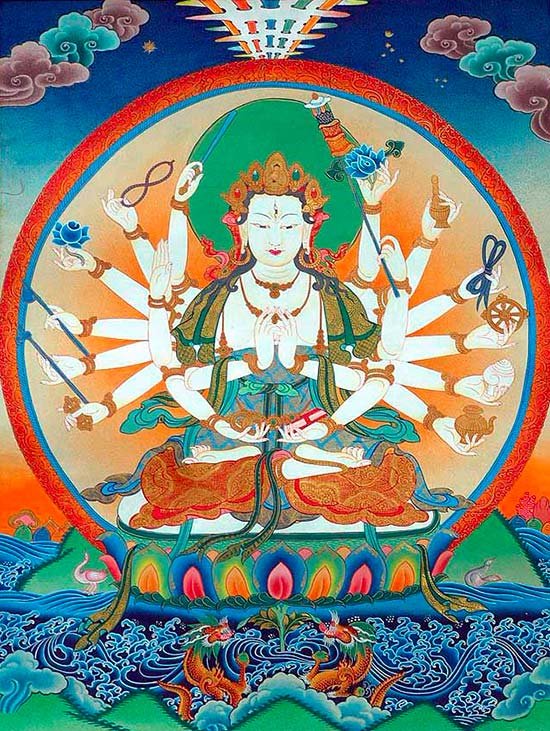Maha Prajnaparamita Sastra
by Gelongma Karma Migme Chödrön | 2001 | 941,039 words
This page describes “shariputra at the festival of giryagrasamaja” as written by Nagarjuna in his Maha-prajnaparamita-sastra (lit. “the treatise on the great virtue of wisdom”) in the 2nd century. This book, written in five volumes, represents an encyclopedia on Buddhism as well as a commentary on the Pancavimsatisahasrika Prajnaparamita.
Part 1 - Śāriputra at the festival of Giryagrasamāja
Note: In this paragraph, the Mahāprajñāpāramitāśāstra regards Śāriputra as a child prodigy; but according to other sources, Śāriputra was much older when he was present at the Giryagrasamāja; moreover, he was accompanied by his friend Maudgalyāyana (Kolita). During this festival, the two friends exchanged disenchanted thoughts on the worthlessness of human pleasures and decided with one mind to leave the world and embrace the religious life: cf. Mahāvastu, III, p. 57–59; Dhammapadaṭṭha, I, p. 89–90 (tr. Burlingame, Buddhist Legends, I, p. 198–199; Fo pen hing tai king, T 190, k. 48, p. 874a–c (tr. Beal, Romantic Legend, p. 325–327); Mūlasarv. Vinaya in T 1444, k. 1, p. 1024 a–b, and Rockhill, Life, p. 44–45.
Furthermore, by his wisdom (prajñā) and his learning (bahuśruta), Śāriputra possessed great qualities (guṇa). In his youth, at the age of eight, he recited the eighteen kinds of sacred books and understood the meaning of all the treatises. At that time, there were two nāga-kings (nāgarāja) at Mo k’ie t’o (Magadha): the first was called Ki li (Giri) and the second A k’ie lo (Agra).[1] They brought the rain at the proper time and the country did not experience the years of famine. The people were grateful to them and regularly, in the [second] month of spring (caitra), they went in a crowd to the nāgas to hold a great festival (mahāsamāja): they played music (vādya) and palavered the whole day. From early times up until today, this assembly was never missed and to this reunion was given the same name as that of the nāgas [namely, giryagrasamāja].[2] On that day, it was customary to set up four high seats (bṛsī), the first for the king, the second for the crown prince (kumāra), the third for the prime minister (mahāmātya) and the fourth for the scholar (vādin).
One day, Śāriputra, who was eight years of age, asked the crowd for whom were the high seats set up. They answered that they were for the king, the crown prince, the prime minister and the scholar. Then Śāriputra reviewed (parīkṣate) the people of his time [and saw] that, among the brahmins, etc., nobody surpassed him in intelligence (abhijñā), charm (prasāda) and beauty of appearance; he therefore mounted the seat of the scholar and sat there cross-legged (paryaṅkaṃ baddhvā).
The people were astounded; some said: “He is a young fool who does not know anything”; others said: “The measure of his wisdom surpasses that of men”.
While admiring his bravery, everyone felt uneasy and, out of regard for his young age, abstained from debating with him. Then they sent their young students to engage him in conversation and question him: Śāriputra’s answers were perfect and his arguments conclusive.
The scholars cried out at this wonder (adbhuta):
“Fools [136b] and wise men, great and small, he confounds (abhibhavati) them all.”
The king quite happily conferred on him a command, the revenue of a village (grāma)[3] which was ceded to him in perpetuity. The king, mounted on an elephant, rang a bell (ghaṇṭā) and proclaimed [the news] everywhere; and in the six great cities of the sixteen great countries (janapada), there was nobody who did not congratulate him.
Footnotes and references:
[1]:
Misled by the Fan fan yu, T 2130, k. 7, p. 1030b, Akanuma (p. 321a, 7b) restores Ki li as Kṛimi and A k’ie lo as Agala. But it clearly concerns the nāgas Giri and Agra whose conversion and adventures are told in Ken pen chouo… yao che, T 1448, k. 4, p. 17a seq. In this translation Yi tsing renders Giri as Chan (46) “Mountain”, and Agra as Miao (38 and 6) “Admirable”.
[2]:
According to this explanation, Giryagrasamāja would mean Festival in honor of the Nāgas Giri and Agra: again, a false etymology has given rise to a myth. In reality, Giryagrasamāja (giriyagrasamāja in Mahāvastu, III, p. 57; girivalgusamāgama in Avadānaśataka, II, p. 24; giraggasamajja in Vin. II, p. 107, 150; IV, p. 85, 267; Jātaka, III, p. 538; Dhammapadaṭṭha, I, p. 89) means simply a festival reunion on the summit of the mountain. Buddhaghosa was not deceived by it and correctly explains: Giriggasamjjo ti girimhi aggasamajjo girissa vā aggadese samajjo. On the nature of this festival, see E. Hardy in Album Kern, p. 61–66. It was a great seasonal festival (Ta tsie houei) celebrated at Rājagṛha and in turn (T 1444, k. 1, p. 1024a19) on each of the five great mountains surrounding the city (T 190, k. 48, p. 874a). The Mppś tells us that it lasted the entire day and took place ‘in the second month of spring”, i.e., the month of Caitra; this indication allows us to correct the reading of the Avadānaśataka, II, p. 24, girivalgusamāgama to giriphālgunasamāgama: “reunion [of the month] of Phālguna on the mountain”. Like all reunions (samāja) of this kind, the festival included spectacles, songs, dancing and music (Mahāvastu, III, p. 57; Avadānaśataka, II, p. 24–25; Dīgha, III, p. 183); special seats were reserved for individuals (T 1444, k. 1, p. 1024a).
[3]:
This is probably the natal village of Śāriputra, situated a half-yojana from Rājagṛha: it was called Nāla or Nālanda (Mahāvastu, III, p. 56, l. 6; Fo pen hing tai king, T 190, k. 47, p. 273c; Ken pen chouo… tch’oukia che, T 1444, k. 1, p. 1022b; Fa hien, tr. Legge, p. 81); Kālapināka (Si yu ki, T 2087, k. 9, p. 924c14), or also Upatissa (Dhammapadaṭtha, I, p. 99).
